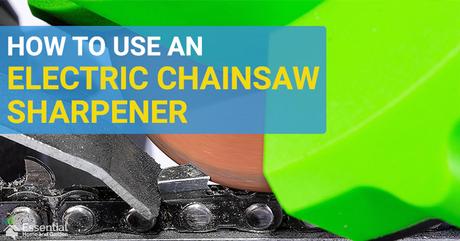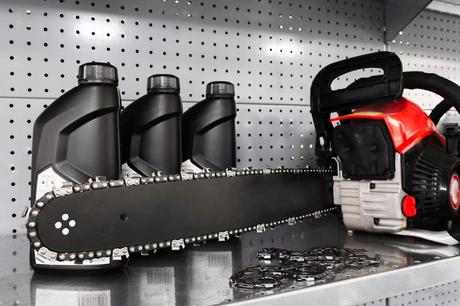
Just like most other home and garden machines, a chainsaw needs regular care for optimal functioning. Unfortunately, you have the engine to think about, as well as the bar, among other components. However, one of the most crucial components about a chainsaw is its blade, without which your chainsaw is practically useless. You'll need a sharp blade to cut through wood, and a chainsaw sharpener is the easiest tool to keep your chainsaw sharp.
Electric chainsaw sharpeners, unlike their manual counterparts, make the sharpening process faster and more precise. Better yet, these sharpeners strip away deeper with every pass; so you will achieve more with minimal effort.
Before we can even learn how to sharpen a chainsaw blade with an electric sharpener, we need to know the right time to use a chainsaw blade sharpener.
Disclosure: It is important you understand that we may receive commissions when you click our links and make purchases. However, this does not impact our reviews and comparisons. All opinions are our own we pride ourselves on keeping our articles fair and balanced. For more info see our disclosure statement.
Click For Article Contents:
When To Use a Chainsaw Sharpener

Once you've decided to use an electric chainsaw sharpener, you need to know when to use it. Sharpening is not an every-day routine so here are three things to watch out for and which indicate the need to sharpen your chainsaw.
- Once you start to see your chainsaw spitting dust instead of some sharp wood chips, it is obvious that your cutters have lost their sharp edge.
- Pay attention to the difficulty you experience while cutting through wood. If you find yourself applying more pressure, then you should know that the teeth are dull.
- The final sign is when your blade seems to pull in a specific direction. This implies that one side of the blade is dull and will need sharpening to balance things out.
Ignoring these signs means that you'll be putting yourself at peril. Dull cutting teeth increases the chances of having a kickback while cutting, which could result in engine damage and severe injuries to you.
Now that we know when to use a chainsaw sharpener, let's learn the steps to follow when sharpening with a chainsaw sharpener.
Steps For Sharpening a Chainsaw Blade With An Electric Sharpener
Sharpening your chainsaw blade might feel intimidating and complicated, but with a little knowledge and the right tool, the process will be a breeze. Here are simple steps to follow when you're looking to sharpen your chainsaw blade.
Step 1: Measure
The first thing to do before getting down to the actual sharpening task is informing yourself on all the specifications of your chainsaw blade. These specifications (pitch and gauge) are incredibly important to know because they affect the chainsaw blade you can use. Luckily, these specifications will often be available on the box in which the chainsaw came. The chainsaw sharpener manufacturer typically provides a manual with instructions that can give a better understanding of the specifications.
However, if you cannot find the manufacturer's manual, you can look up on the internet or contact the manufacturer for some insight into measuring your chainsaw blade accurately. With the right measurements in your hands, you can get the right size stone for sharpening.
Step 2: Positioning
Once you know the pitch and gauge of your chainsaw, you need to position your electric chainsaw sharpener tool appropriately.
To prevent shaking or movement during operation, it is advisable that you place your sharpener on the ground.
Chainsaw sharpeners also come as bench-mount options which are held firmly on a workbench by a vise.
Positioning your chainsaw sharpener in a rigid position is essential because it makes it easy for you to install the chainsaw blade on your sharpener. Better yet, the right positioning also makes for a smooth sharpening process.
Step 3: Install the Sharpening Stone
Once your chainsaw sharpener is ready, you will need to go ahead and install a sharpening stone. For a successful installation, however, it is important that Step 1 discussed earlier be done with precision to get the right measurements. With all the details obtained about the specifications (pitch and gauge), you'll install your sharpening stone with the right width so that it fits in the gap that's between the chainsaw blade's teeth.
Typically, the width of a sharpening stone usually is 3/16 inch. It is important to note that that there are different sharpening stones so be sure to use one that fits your blade's specifications.
Step 4: Swivel
Swiveling is the next thing you need to do after installing the sharpening stone. You will need to place the blade in the chainsaw sharpener's holder and then adjust the angle.
Typically, the most common angles are usually between 0 degrees and 60 degrees. In some special cases, however, the angle could go to 80 degrees.
Step 5: Angle
At this stage, you will need to refer back to the specifications to know the tooth angle given. You can easily adjust the blade tooth angle in the chainsaw sharpener by loosening a knob located on the blade's holder. For accurate setting, this knob should be moved in different directions, either the positive or negative.
Step 6: Adjust the Depth
Adjusting the depth is essential since the depth stop must be properly positioned to prevent the grinder from cutting too deep. Failure to adjust the depth properly increases the chances of sharpener's grinder cutting the metal found between the blade teeth, resulting in a damaged blade. In addition, the blade could overheat and the construction material loses its integrity.
Step 7: Time to Sharpen
By now, everything is set so you can start sharpening. Slowly lower the grinder wheel on the blade's first tooth and once it makes contact, you will see some sparks. After keeping them in contact for a short period, lift the grinder and check to confirm that the tooth's inner surface has a shiny finish. You have sharpened your first tooth and probably have 60 more to go.
Now proceed and slowly sharpen every tooth on one side of the blade. Once you're done with a set of teeth, you will need to readjust the grinder. For instance, if you had set it to 20 degrees on the positive side, you need to change it to 20 degrees negative. Once this is done, you can sharpen the next set of teeth.
From the steps above, sharpening a chainsaw blade isn't difficult. Just be sure not to miss any step in the whole process. It is also advisable that you rock some protective gear to keep yourself safe.
